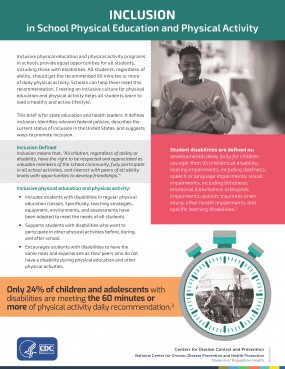Inclusive School Physical Education and Physical Activity
All students, regardless of ability, should get the recommended 60 minutes or more of daily physical activity. Schools can help all students meet this recommendation by providing equal opportunities for students with disabilities.1 Creating an inclusive culture for physical education and physical activity helps every student learn to lead a healthy and active lifestyle.
Inclusion means that, “All children, regardless of ability or disability, have the right to be respected and appreciated as valuable members of the school community, fully participate in all school activities, and interact with peers of all ability levels with opportunities to develop friendships.”2
Inclusive physical education and physical activity:
- Includes students with disabilities in regular physical education classes. Specifically, teaching strategies, equipment, environments, and assessments have been adapted to meet the needs of all students.
- Supports students with disabilities who want to participate in other physical activities before, during, and after school.
- Encourages students with disabilities to have the same roles and experiences as their peers who do not have a disability during physical education and other physical activities.

Download the research brief [PDF - 1 MB], Inclusion in School Physical Education and Physical Activity.
Federal law requires states, districts, and schools to provide children and adolescents with and without disabilities equal opportunity to participate in physical education and physical activity.3
- The Americans with Disabilities Act (ADA) bans discrimination on the basis of disability.4 Therefore, schools are required to comply with the accessibility requirements of the ADA and provide appropriate physical education and physical activity opportunities for students with disabilities.
- Section 504 of the Rehabilitation Act and Title II of the ADA are federal civil rights laws that prohibit disability discrimination, including in schools.5
- The Individuals with Disabilities Education Act (IDEA) provides for a “free appropriate public education” in the “least restrictive environment” to all children with a disability.1 IDEA also states that students with disabilities are to participate in physical education with children without disabilities to the maximum extent appropriate. IDEA includes language for instruction in physical education that may be a part of the special education services prescribed in students’ individualized education program (IEP), a legally binding document that has been tailored specifically to a child’s educational needs.
Schools are required to have adequate policies and practices that align with the federal policies for inclusion. Schools also need to be aware of any additional policy guidance from their state or school district. At the state level, relevant policy information might be found in the 2016 SHAPE of the Nation report and NASBE’s state policy database.6,7 At the district level, expectations for inclusion might be found in the local wellness policy.2 See examples of model wellness policies for inclusion.
Most school districts require schools to meet the physical education needs of students with disabilities by8:
- Including accommodations in physical education in 504 plans or IEPs (98%).
- Mainstreaming into regular physical education as appropriate (97%).
- Providing adapted physical education as appropriate (91%).
Among schools that have students with disabilities, 91% include physical education in IEPs or 504 plans for these students.9
Among schools that have students with disabilities, 62% require students with long-term physical, medical, or cognitive disabilities to participate in physical education.9
However, 52% of schools exempted students with cognitive disability, and 86% exempted students with long-term physical and medical disability from physical education. Both percentages increased between 2000 and 2014.9
More information and data can be found in CDC’s research brief, Inclusion in School Physical Education and Physical Activity [PDF – 697 KB].
Below are six actions state leaders can take to promote inclusion in physical education and physical activity at the district and school levels.
- Share any state laws, policies, and guidance for participation in physical education and physical activity for students with disabilities with district and school staff. This includes policy language around inclusive physical education and physical activities, adapted physical education, professional development for administrators and staff about building a culture of inclusion, and certification of staff working with students with disabilities.
- Share your state-level data about students with disabilities with educational and health leaders. The National Survey of Children’s Health provides an interactive data query site that you can use to identify state estimates about students with disabilities. Starting in 2020, CDC’s School Health Profiles survey will have two questions related to inclusion.
- Identify and reach out to state and district partners that are already leading inclusion efforts and look for opportunities to collaborate. Potential partners include state disability program staff, Special Olympics state affiliates, local university departments working on adapted physical education and inclusion, state Society of Health and Physical Educators (SHAPE) America affiliates, adapted physical education specialists, adapted sport programs or clubs, and allied health–occupational, physical, and speech therapists. CDC funds 19 states under the State Disability and Health Programs.
- Conduct a brief assessment of current activity and needs. This assessment should identify any current activities for inclusion at the state and district levels (e.g., programmatic efforts, built environment improvements, funding, professional development) and any needs at the district and school levels for inclusion. The National Center on Health, Physical Activity, and Disability’s Community Health Inclusion Index is an example of an assessment tool. It is designed to collect information about healthy living resources and the degree to which they are inclusive.
- Provide training to district and school staff on how to create an inclusive Comprehensive School Physical Activity Program (CSPAP) to ensure that physical activity opportunities are accessible and inclusive before, during, and after school.
- Engage partners and university programs to train current and future school leaders, physical education teachers, and classroom teachers on best policies and practices for inclusion. This could include learning about how to make adaptations and accommodations to facilities, rules, equipment, instructions, and assessment.
